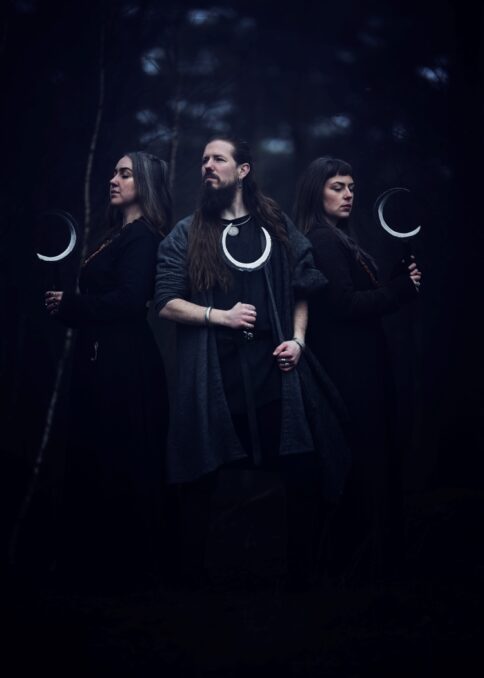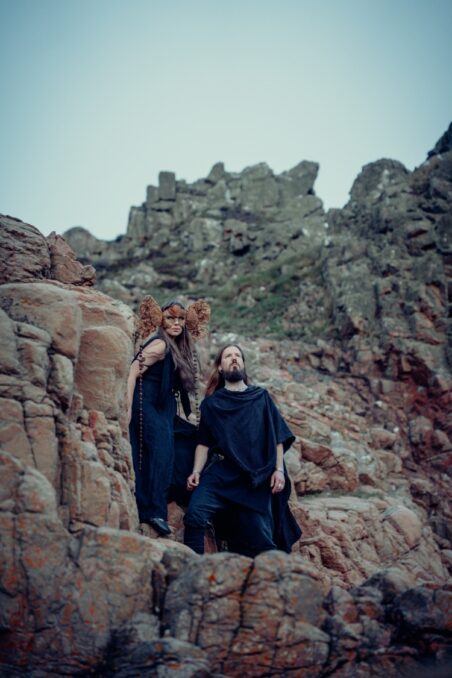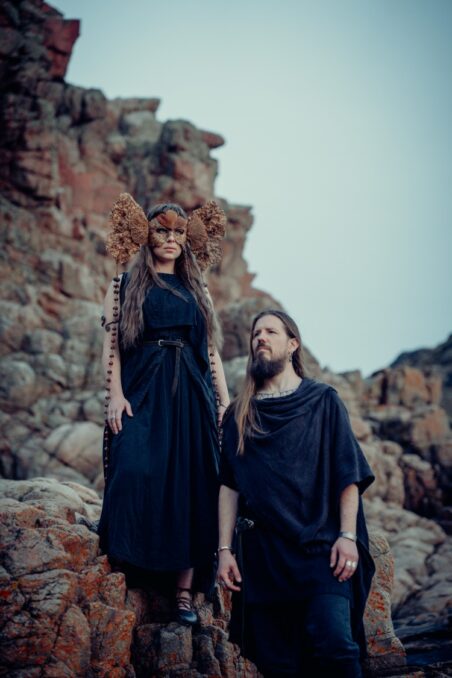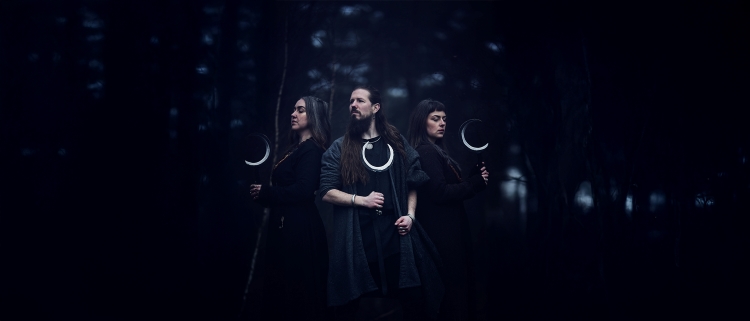The continuous cycles of the universe take center stage in Sowulo’s new album NIHT, a work steeped in the spiritual philosophy of ancient Northern Europe. Guided by founder Faber Horbach, Sowulo explores themes of darkness, renewal, and timeless human connection. For the first time, Sowulo singer Micky Hujisman speaks about “NIHT” accompanying the release. Fresh from the new singles “Āsteorfan” and “Sōl ond Māni”, the band unveils a new chapter under the banner of Season of Mist, offering an immersive journey through myth, memory, and the eternal night.

Welcome to Sowulo
First of all, Micky, thank you for accepting the interview. Welcome to Femme Metal Webzine. How are you, and how has this period been treating you?
Well, thank you for having me. I’m doing well. We’re extremely busy at the moment because we just released our first single, “Āsteorfan”. Tomorrow we’ll be filming the video for our second single, which will be out very soon.
So yes, it’s a hectic time. Tomorrow is a full day of shooting, and of course, we’re also doing a lot to promote the upcoming album. There’s so much happening right now.
“NIHT” has been a long time in the making
I wanted to start by asking you about this amazing album that’s about to be released in August. I’ve forgotten the exact date—as usual—but I’d like to hear about the production of “NIHT”. When did you start putting together the first ideas for this album, especially after such a successful tour in the Netherlands and a special date in Paris, France?
This album has been a long time in the making. Some of the singles—like all the moon-themed tracks—were released earlier. That’s four singles in total, and they came out ahead of schedule because we originally expected the album to be ready sooner. But then life happened.
“NIHT” is the Anglo-Saxon word for “night,” which in this case is also symbolic of death. Over the past few years, we’ve experienced both literal loss and symbolic endings. It’s interesting how that aligns with the album’s concept.
Faber usually has a very clear vision for each album—a concept that often ends up feeling like a prediction of what’s to come. When he decided this one would center on the night as a metaphor for death, it turned out to be an ominous sign. It was a difficult period, and that’s part of why the album took longer to complete.
“Sowulo is all about the cyclical nature of life”.
It became a journey into darkness—facing challenges, external pressures, and personal loss. Some of Faber’s close relatives passed away during this time, which was deeply affecting. On one hand, you were trying to create this artistic journey, and on the other, you were dealing with grief. How did these experiences shape the album?
Yeah, well, Sowulo is all about the cyclical nature of life, and that’s in everything. For people who may not be so familiar: cyclical nature is something we find in the day—morning, afternoon, evening, and then night—and then the cycle repeats. In a human life, for example, you have birth, childhood, adulthood, and then the slow decay, and finally death.
That also means death and creation are closely connected. From a creative standpoint, when starting a project, you need some sort of nothingness, death, or emptiness to be able to create something. So, in my opinion, it’s very logical that those two things go together. In this case, it was indeed the physical loss of both Faber’s father and stepfather. It’s really hard, but it’s also logical if you see it from a cyclical point of view—those two don’t necessarily come one after the other, but they balance each other.
The lyrics in Proto-Germanic part 1
There’s a long red thread connecting them. And, you know, you spoke about this Proto-Germanic language, and I’m curious, because even though I speak Dutch, I understand only a few words here and there. When you and Faber write lyrics together, is there academic help to double-check the grammar? I imagine it might involve people from Leiden University, because this is such a specialized area of study. How does Faber approach songwriting in Proto-Germanic, since it’s not like writing in English or Dutch where you can just run a check on the computer? I don’t think Proto-Germanic exists in that way at all.
The process has evolved over the years. The first album that used such lyrics was the “Mann” album, based on some Anglo-Saxon poems. Wurdiz, the album after that, was the first time Faber started working with the University of Leiden. It’s a whole field of study. You can do it alone, without academic help, but it’s very difficult. It’s not the easy road, but I think that says a lot about his determination to use Anglo-Saxon—it has such magic in it. It’s related to Old Dutch, the language of our ancestors. But I also think there’s magic for the listener in not being able to understand the words. You listen to the music differently.

The lyrics in Proto-Germanic part 2
It’s like listening to a language I don’t know, like Finnish. You just immerse yourself in it. That’s the feeling I get when I listen to Sowulo. I do have some advantage—I have a B1 level in Dutch—so I can catch a few words. But I don’t stop to analyze; I just enjoy listening. I’m amazed by the work that goes into it, because I don’t even know if grammar books for Proto-Germanic exist.
Usually, Faber writes most of the lyrics. We start in modern English, then use some words we already know to create a rough, incorrect Anglo-Saxon version. Alongside the modern lyrics, we work with an amazing professor and students from the University of Leiden. They don’t just translate—they also ask questions. The strange thing is that language gets less complicated over time. Anglo-Saxon grammar is much more complex than what we have now. For example, the grammar changes depending on whether you’re speaking to one person, two people, ten people, or a hundred. We don’t know that by heart, so they guide us. It’s a nice collaboration. They also help with pronunciation. Sometimes the first draft and the final version are quite similar, but usually they’re not, and we have to adapt the lyrics so they fit the melody. It’s a lot of work, but worth it.
Micky working together with Faber and more
I find your compositions powerful—raw, but in a way that I love. You just told me Faber is the main composer, but how do you participate in the structure of the album? I know you play some instruments, but when do you give your input?
I joined Sowulo about four years ago, and at that time, most of the “Wurdiz” album was already written. Faber had already composed about 90% of the parts I was going to perform, so my contribution grew over time.
After Wurdiz, we started making the moon songs that have already been released, and now the “NIHT” songs. I got to participate more, which was fun, because then it feels like it’s truly yours—we joke that it’s like your child, whether it’s an album or a song. I feel much more connected to the new songs because I was more involved in creating them. On the new album, I wrote some songs myself—two of them entirely—and I also wrote the vocals for “Sōl ond Māni”, the new single coming out soon.
Micky working together with Faber and more part 2
“Sōl ond Māni” is my new favorite song. The collaboration between me and Faber worked perfectly. He wrote this amazing musical piece with a broken nickelharpa and said, “Do your thing. The song is here—see what you want to do.” So I wrote the melody, and he was very enthusiastic about it, as was I. That was that.
The collaboration has been great in that regard. Behind the scenes, I’m also more involved—creating the artwork, designing T-shirts, and managing social media. So yes, I’m busy both on and off stage.
The visual concept for the video of “Āsteorfan”
Okay, you know, you mentioned also “Āsteorfan”’s video. And I saw the video—it’s great, it’s amazing, like the song. And, you know, I wanted to ask you about how the shooting of that video was. Because, yeah, actually, it’s quite amazing, and I wanted to ask you more about the behind-the-scenes, all the pre-production, production—call it whatever you want. How was it to shoot that video?
Yeah, the “Āsteorfan” video was a bit of my project. Faber and I discussed what the concept visually should be, because “Āsteorfan” is about loss, but it’s also some sort of victory anthem to me—overcoming difficult times in life and finding strength in those dark periods, and wisdom that you would otherwise not have obtained if not for those very difficult times. I thought it would be an amazing visual idea to have the video go from day to night, and then in the night, have this fire walk, which is very frightening and like a death in and of itself. So we thought that would be very powerful to visualize the concept of the song that way.
One of the cool things is that, in the last month, Faber and I moved together to Sweden, and some of the shots we filmed were actually in our backyard. All the fire shots and the fire walk were in our backyard, which was very special to also initiate our place like that. Those parts are very dear to me. We also took advantage of the beautiful Swedish landscape around us and filmed on these beautiful cliffs. And we got to film in a beautiful cave, which was very fitting for the calm setting of the night.

Sowulo is raising the stakes always higher
I have to say, I find that piece — and the video clip — truly amazing. My congratulations to you. As I mentioned earlier, the album is coming out at the end of August. With the previous release, you already went on tour and played quite a few dates. Now, with “NIHT“, the stakes feel even higher — both because of the album itself and the powerful live experience Sowulo brings to the stage. My question is: do you have plans to bring “NIHT“ to life on stage in the future, or will it be limited to just a small number of exclusive events before drawing the curtain?
Yeah, we’re planning to bring this album to life on stage as well. We’re already planning for an album release show, which will be very special, and we’ll have the whole Viking orchestra there. After that, it’s probably a lot of festivals, but we’ll have to see the schedule. We’re planning on doing more songs from the “NIHT” album live.
The next challenge
It’s going to be challenging, I think, given the structure of the album—it will be quite demanding and challenging. So I was wondering how you want to bring in a live setting, because you need, I think, seven or eight different people to play different instruments. I know that Faber plays almost everything, but he only has two hands… [laughs]
Well, luckily, we have a lot of people on stage. If we’re at full force, we’re nine musicians. We have three people on strings, and we have a harp, so we have a lot of elements from the “NIHT” album to bring that to life. But yes, every album and every new song you integrate into a set is a challenge.
Usually, it’s a challenge you don’t expect beforehand. Sometimes things just sound different when you do them live, or you have to alter certain parts—but in the end, it always works out. So I can’t say for certain what challenges these songs will pose, because we haven’t rehearsed yet, but I’m sure it will be fun.
Closing words
Yeah, I’m looking forward to it then. Well, Micki, I want to thank you for your time, for replying to my questions, and for taking the time to do the interview. I hope you enjoyed it, and I want to thank you again. That’s all from me.
Yeah, thank you again for having me. It was fun. This was my first solo interview.
